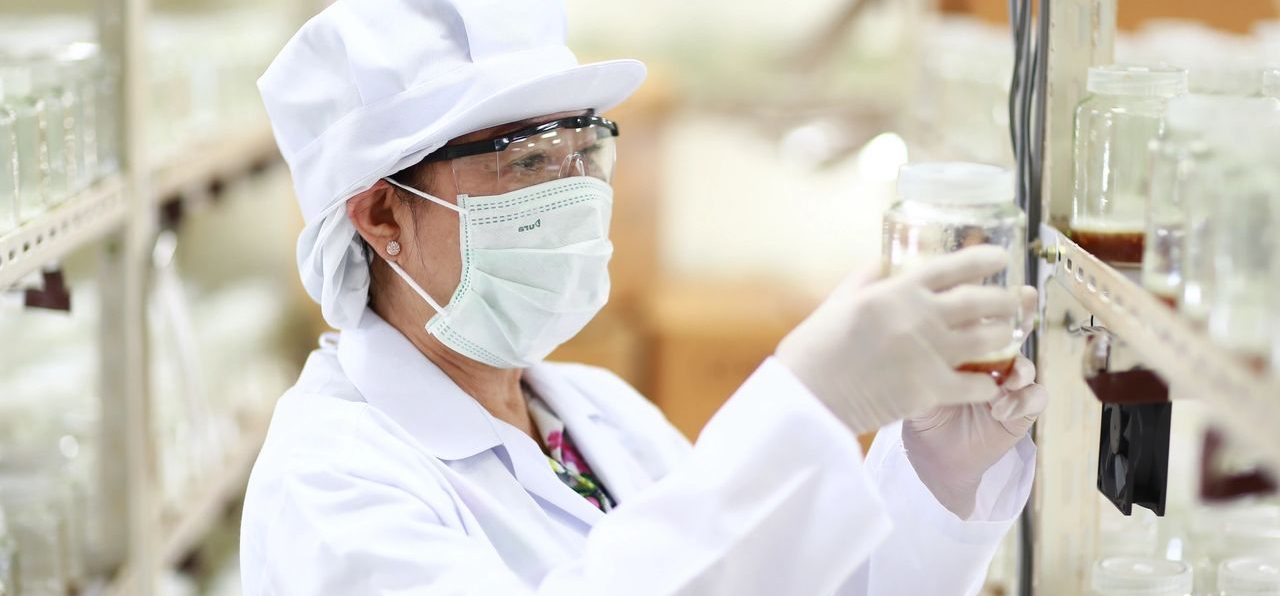Cordyceps are a genus of fungi that are found growing on the larvae of insects. Over four hundred (400) species have been discovered across the world. Cordyceps sinensis has been used as an herbal drug in Chinese pharmacopeia since 1964. It has been used in the treatment of coughs, chronic bronchitis, respiratory problems, kidney problems, nocturia, hypo-sexuality, anemia, irregular heartbeat, liver problems, weakness, dizziness, weight loss, and tinnitus. It is also proven to strengthen the immune system, improve athleticism, and help to combat the effects of aging. Looking at its composition can help us to understand why something so small is so powerful and valuable.
Several active ingredients, such as Cordycepin triphosphate, have been isolated from various Cordyceps species and can account for their bioactivity.
Nucleosides
These are one of the primary components in Cordyceps. Nucleosides and their derivatives have found widespread applications in the development of anticancer and antiviral therapies. Since Cordycepin was first isolated from cultured Cordyceps militaris, nucleosides in Cordyceps have become a popular focus area.
More than ten (10) nucleotides and related compounds isolated from Cordyceps sinensis, including adenine, adenosine, cytosine, cytidine, uracil, thymidine, and guanosine, to name a few. Through different studies carried out, nucleosides have proven to have many applications in regulating many physiological activities within the body, mediated through the activation of two specific receptors. As such, carefully studying these nucleosides and their associated compounds (and by extension their properties) are of great benefit. The main nucleosides we will focus on are Adenosine and Cordycepin.
Adenosine
Adenosine plays an essential role in many biochemical processes within organisms and is a primary nucleoside in the Cordyceps species. Adenosine A1, A2A, A2B, and A3 receptors are distributed throughout the brain, lung, heart, liver, and kidney, and they are involved in activities regulated by the central nervous system, including sleep, respiration, cardiovascular function, immune response, and various activities of the liver and kidney.
The distribution and role of these adenosine receptors, anti-cancer, anti-aging, anti-thrombosis, anti-arrhythmias, and their protective effect on the kidneys, liver, and lungs have all been found as pharmacological effects of Cordyceps. Adenosine is thought to suppress cell growth through many extrinsic and intrinsic signaling pathways. Macrophages (a type of white blood cell) express adenosine receptors and play a critical role in the immunological activity of the body. They up-regulate (increase the number of receptors) and down-regulate (decrease the number of receptors) specific immunological mediators or factors.
Sterols
Several sterols, including ergosterol, have been identified in Cordyceps. Results of a study conducted in 2009 evidence that ergosterol exists in both free and combined forms in Cordyceps. The content of the free form is relatively high in both the natural and cultured states. Ergosterol plays a vital role in synthesizing vitamin D2, which plays a critical role in bone development in humans.
An article published in the Nutrition and Cancer journal in 2000 found that phytosterols, especially Beta-sitosterol, have a protective role against certain types of cancer, namely colon, breast, and prostate cancer. Study shows that phytosterols decrease cholesterol absorption while being inadequately absorbed themselves. The bioactivities (acting on a living thing) of sterols highlight the therapeutic indications of Cordyceps in hyperlipidemia and cancer.
Free Fatty Acids (FFAs)
Ten free fatty acids (FFAs) have been found in natural and cultured Cordyceps. The prime free fatty acids found are palmitic acid, linoleic acid, stearic acid, and oleic acid. These are not only essential nutritional compounds, but they also modulate many cellular activities through their receptors. The activation of FFA receptors has several physiological effects and has, therefore, become the focus of novel therapeutic targets in the treatment of diabetes, dyslipidemia (abnormal amount of lipids), and immunomodulation (Change in the body’s immune system, caused by agents that activate or suppress its function), especially, type 2 diabetes.
Research has shown that through the activity of these FFAs, insulin release can be stimulated from specific cells within the pancreas, producing a hypoglycemic effect, and they can also indirectly promote glucose-stimulated insulin secretion and then inhibit blood glucose level by activation of receptors in the intestinal tract. Free fatty acids also carry out significant immunomodulatory activities through the activation of their receptors on immune cells.
Carbohydrate
Cordyceps contain high amounts of polysaccharides (the most abundant carbohydrate found in food), constituting between 3–8% of the total dry weight and these polysaccharides are the chief contributors to their pharmacological properties. Some studies have suggested that the pharmacological activity is directly correlated to characteristics such as molecular weight and that anti-tumor activity is exhibited only if the molecular weight exceeds 16000.
Experimental evidence has given credence to the wide range of bioactivities associated with fungal polysaccharides, including anti-tumor, antioxidant, immunopotentiation, hypocholesterolemic, and hypoglycemic effects. However, its applications have been limited because it has been over-harvested resulting in limited available supply (it is an endangered species). A large amount of D-mannitol (a form of sugar) is found in Cordyceps. D-mannitol, also known as cordycepic acid, was first isolated from Cordyceps in 1957. It is one of the dominant compounds in Cordyceps, constituting over 3.4% and 2.4% of the total dry weight, respectively.
Research conducted on the osmotic activity (a passive process in which water diffuses across a cell membrane) of D-mannitol has found that it is useful in the treatment of cerebral edema and refractory intracranial hypertension resulting from traumatic brain injury, subarachnoid hemorrhage, and stroke. It is also thought to have applications in the treatment of acute renal failure. A study conducted in 2008 showed that when its dry, powdered form is used, it is a powerful therapeutic agent in the treatment of respiratory conditions such as cystic fibrosis. Inhalation of its powdered form rehydrates the airway and increases the ability of the body to clear mucus.
Mannitol has also been used as a diagnostic test for airway hyper-responsiveness to help in the diagnosis of asthma. These pharmacological effects of D-mannitol provide support for the use of Cordyceps in the treatment of respiratory ailments such as asthma and chronic bronchitis, as well as other health problems such as renal dysfunction and renal failure, and hypertension.
Cordycepin
Cordycepin is a unique medicinal compound found only in the Cordyceps species. It was first isolated in 1950 from Cordyceps militaris and the first scientific article published. It mainly exists as a cultured Cordyceps extract, and there is little to none found in cultured Cordyceps sinensis. Cordycepin has significant therapeutic potential and exerts its influence on numerous cell targets, including acids, the cell cycle, and cell death. Some of its most impressive activities are as follows:
● It may possess anti-cancer, immunomodulating, and antioxidant capabilities. Clinical trials have been conducted to investigate the possible application of Cordycepin in the treatment of lymphocytic leukemia, and there have been studies where Cordycepin has exhibited cytotoxic effects on tumor cells. Studies on mice have shown that Cordycepin exhibits a distinct apoptotic (cell death) mechanism through Cordycepin stimulated intracellular signal transduction pathways to induce cell death in tumor cells. In these same studies, Cordycepin benefits body organs by stimulating the release of cytokines. It also promoted the reproduction of some immunological cells and their required factors. Therefore, Cordycepin can intensely regulate the functions of human immune cells.
● A study conducted in 2009 found that Cordycepin is capable of exhibiting cardioprotective effects by acting as an anti-atherosclerotic agent through the activation of the A1/A2 receptor expressed in vascular cells.
● Another Cordycepin benefit is that it may aid with the prevention of focal cerebral ischemic/reperfusion injury. Researchers have suggested that Cordycepin has a neuroprotective effect on the ischemic brain, due to its ability to inhibit inflammation and increase antioxidant activity associated with lesion pathogenesis (development of a disease), as found by a study conducted by Wang et al. in 2012. This also means that Cordycepin could become an attractive therapeutic option for ischemia-reperfusion-associated heart diseases such as myocardial infarction.
● Cordycepin has shown explicit analgesic capabilities when investigated using acetic acid-induced abdominal constrictions, hot plate tests, and assay in mice. Experts examined the potent anti-inflammatory and analgesic properties of Cordycepin, and the findings were published as well.
Cordycepin is a broad-spectrum biocidal compound that has antitumor and antibacterial, antivirus, and insecticidal activity.
It Is Easier To Digest Cordyceps Extract Versus Non-extracted Cordyceps
In fungi, the cell wall is made up of chitin (the same material that covers crabs) which accounts for its rigidity and structural strength. Extracting Cordyceps breaks down the cell wall and allows our body to more easily access the active constituents found within. Non-extracted Cordyceps tend to be indigestible because the enzyme chitinase, required to break down chitin, is usually inactive in our stomach. Non-extracted Cordyceps may be a more affordable option to Cordyceps extracts, but they, unfortunately, will not result in any significant therapeutic effects. At Cordythai USA, we ensure to use state-of-the-art water extraction so that our products are completely and digestible and will provide essential Cordycepin benefits for you to achieve your health goal.
It has, therefore, been shown that Cordyceps have several bioactivities, including anti-tumor, antioxidant, immunomodulation, sexual and digestion enhancement, hypoglycemic, and protective effects on the kidney and liver. As such, it is a worthy health investment. To derive the desired benefits, you need Cordyceps products that are formulated correctly. So ensure you compare brands to look at their components. Choose the brand that will ensure you achieve your health goal. In our next post, we will discuss further factors that contribute to the quality and value of Cordyceps extract.
Cordyceps extract is available in many different formulations on the market, including tablets, capsules, and powders. When extracting Cordyceps mushrooms, a powder is produced that is highly concentrated in bioactive compounds such as Cordycepin triphosphate. To maximize the health benefits from the Cordyceps, it is best to use an extract in capsule or powder form. We offer you high-quality, concentrated Cordythai Cordyceps capsules.

